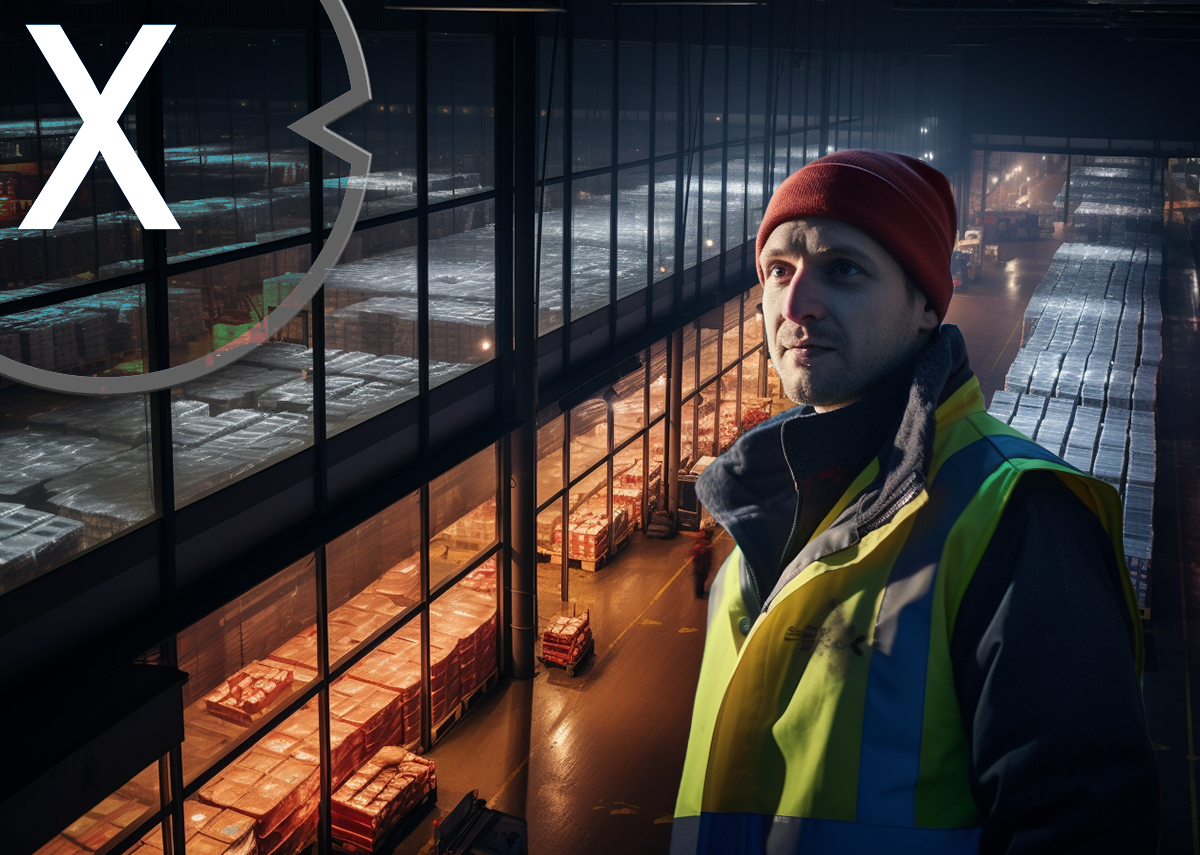
Warehouse optimization – Fresh logistics expansion – Cooling logistics expansion – Image: Xpert.Digital – AI & XR 3D rendering machine (art photo/AI)
🌿 Sustainability in cold chain logistics: How can CO2 emissions be reduced? 🌍
🥶🌍 Reduction of CO2 emissions and energy consumption
Sustainability in cold chain logistics is a key issue in the fight against climate change and its resulting environmental impacts. Since cold chain logistics represents a significant portion of global energy consumption and consequently generates large amounts of CO2 emissions, innovative approaches and technologies are crucial for reducing these burdens.
👨🔧🌡️ Optimization of cooling systems and refrigerants
One of the first steps towards more sustainable cold chain logistics is optimizing the cooling systems used. Modern refrigeration equipment should not only be energy-efficient but also as free as possible from climate-damaging refrigerants. The use of natural refrigerants such as ammonia or carbon dioxide can play a significant role here. These refrigerants have a lower global warming potential than the conventionally used hydrofluorocarbons (HFCs). Furthermore, innovative insulation methods, such as vacuum insulation panels, can be used to reduce the energy required for cooling processes.
🚚🔌 Vehicle technology and alternative fuels
Significant savings potential also exists in the field of vehicle technology. Electrically powered transport refrigeration systems or those powered by alternative fuels such as LNG (Liquefied Natural Gas) or biofuels can contribute to a reduction in CO2 emissions. Hybrid technologies, which switch between electric and combustion engines during operation, also help to lower emissions.
📲🚛 Digitalization and intelligent logistics
Digitalization and intelligent logistics are further key components for a more sustainable cold chain. Telematics systems make it possible to monitor the condition of the cargo in real time and regulate cooling capacity as needed. This not only leads to lower energy consumption but also to less food waste, as the products are transported under optimal conditions. Similarly, dynamic route planning systems can help optimize routes and avoid empty runs, which directly translates into a reduction in fuel consumption and CO2 emissions.
♻️📦 Transport efficiency and reusable packaging
Furthermore, increasing transport efficiency through improved loading methods and the use of reusable packaging is another aspect of increasing sustainability in cold chain logistics. Standardizing load carriers ensures better space utilization in transport vehicles and storage containers and reduces additional packaging waste.
🌞 Renewable energies in cold chain logistics
It is also essential to source as much of the energy used in cold chain logistics as possible from renewable sources. Photovoltaic modules on warehouse or truck roofs can help generate electricity locally for refrigeration systems or even directly for electric refrigerated trucks.
♻️ Circular economy in cold chain logistics
The circular economy is playing an increasingly important role. Implementing a return logistics system for packaging and reusing or recycling refrigeration equipment at the end of its life cycle can contribute to reducing the carbon footprint.
🧠 Awareness raising and training
Another approach is to raise awareness among everyone involved in the cold chain. Training for drivers on eco-efficient driving techniques and the correct use of refrigeration systems, as well as educating consumers about the importance of sustainably transported food, can have a significant impact.
🔧 HFC Leakage Management
Raising awareness of issues such as HFC leakage management, which deals with preventing the release of climate-damaging gases from cooling systems, is also of enormous importance.
🔄 Implementation of measures to reduce CO2
In summary, a number of measures must be considered and implemented to reduce CO2 emissions in cold chain logistics. The use of eco-efficient refrigeration technologies, the deployment of clean energy sources, the optimization of transport routes and resources, the introduction of intelligent control systems, and a commitment to a circular economy are all essential pillars for more sustainable cold chain logistics.
🤝 Shared responsibility for a sustainable future
Industry decision-makers are equally called upon to drive developments in this area and to continuously question themselves in order to promote and implement innovations. Policymakers, too, are challenged to create supportive frameworks through subsidies, legislation, and standards. Ultimately, a shift towards greater sustainability in cold chain logistics requires the collaboration of all stakeholders: manufacturers, logistics companies, retailers, consumers, and political actors. Only when all parties work together and take responsibility for their processes and products can the ecological footprint of cold chain logistics be sustainably reduced.
📣 Similar topics
- 🌍 Sustainability in cold chain logistics: Measures to reduce CO2 emissions
- ⚡️ Cooling systems for a greener future: Innovative approaches in cold chain logistics
- 🚚 Sustainable vehicle technologies in refrigerated logistics: Reducing CO2 emissions
- 🌐 Intelligent logistics for a sustainable cold chain: Digitalization and telematics systems
- 🌱 Reusable packaging and load optimization: Increasing transport efficiency in cold chain logistics
- ☀️ Renewable energies for cold chain logistics: electricity generation and energy sources
- 🔁 Circular economy in cold chain logistics: Reuse and recycling of refrigeration equipment
- 👥 Raising awareness for a sustainable cold chain: training and consumer education
- 🌡️ Prevention of HFC leaks: Management of climate-damaging gases in cooling systems
- 🌍 Sustainable cold chain logistics: Challenges, opportunities and collaboration
#️⃣ Hashtags: #Sustainability #ColdLogistics #EnergyEfficiency #Digitalization #ReusablePackaging
🧊 Technology leader Japan in refrigerated logistics – better working conditions optimize distribution processes
Refrigerated logistics/fresh logistics: Cold storage with automated material flow optimizes distribution processes - Image: Xpert.Digital
Asian countries such as Japan in particular are considered pioneers here. Tokyo, one of the largest cities in the world with over 38 million inhabitants, impressively shows how high population density and quality of life can be combined with the help of innovative urban and infrastructure planning. The expansion of efficient transport and supply systems has been the focus here for decades.
More about it here:
Xpert partner in warehouse planning and construction
⚡🔄🤝 Global commitment to local cold chain logistics: Networked strategies for emission reduction
🌐 Global importance of cold chain logistics
Cold chain logistics is an essential component of the global supply chain, especially for food and pharmaceutical products. It plays a crucial role in maintaining the quality and safety of temperature-sensitive goods. However, cold chain logistics is also associated with high CO2 emissions. Reducing these emissions is therefore important not only for environmental reasons, but also to meet legal requirements and customer expectations for a sustainable supply chain.
💡 Improve the energy efficiency of cooling systems
Improving the energy efficiency of cooling systems is the first step towards reducing CO2 emissions. Modern cooling units can significantly reduce energy consumption. For example, using CO2 as a refrigerant in transportation systems can reduce environmental impact compared to conventional refrigerants. CO2 is a naturally occurring gas with a low global warming potential (GWP) and can therefore contribute to mitigating the greenhouse effect.
🔄 Optimizing transport routes
Optimizing transport routes also plays a major role. By using route planning software, routes can be chosen to be as short and efficient as possible. This not only leads to lower fuel consumption but also to less congestion and traffic, which in turn reduces CO2 emissions.
🚗 Use of hybrid and electric vehicles
Furthermore, the use of hybrid or electric vehicles in refrigerated logistics can make a significant difference. While initial investments may be higher, such vehicles save costs and reduce emissions in the long run. In cities where air quality is a major concern, electric vehicles can even contribute to a better quality of life.
🧊 Improving the insulation of refrigerated transport units
Another approach is to improve the insulation of refrigerated transport units. High-quality insulation materials can help reduce the energy consumption of these units to keep goods at the required temperature. This is particularly relevant for long transport routes where goods need to be kept refrigerated for hours or even days.
☀️ Implementation of alternative energy sources
The implementation of alternative energy sources such as solar panels on storage and transport units can also contribute to CO2 reduction. These can supply or at least supplement the energy required for cooling systems, thus reducing dependence on fossil fuels.
🌐 Holistic view of the supply chain
A holistic view of the supply chain is necessary to increase sustainability. This includes the take-back and recycling of packaging materials as well as the prevention of food waste through improved demand planning and management.
👥 Involving all stakeholders in the supply chain
Finally, it is important that all stakeholders in the supply chain are involved in sustainability efforts. Close collaboration between manufacturers, logistics providers, and retailers can lead to innovative solutions that are both economically viable and environmentally friendly.
📈 Measures to reduce CO2
In summary, reducing CO2 emissions in cold chain logistics requires a range of measures: from technical improvements and more efficient energy management to the optimization of transport routes and the use of alternative drive systems, as well as better planning and collaboration along the supply chain. Only through the interplay of these factors can the challenges of sustainability in cold chain logistics be overcome and CO2 emissions significantly reduced.
📣 Similar topics
- 🍃 Sustainability in cold chain logistics: How to reduce CO2 emissions?
- ⚡ Energy efficiency in cold chain logistics: Ways to reduce CO2 emissions
- 🚛 Optimizing transport routes: Less CO2 in refrigerated logistics
- 🚗 Electric vehicles in refrigerated logistics: A sustainable solution
- 🏗️ Improved insulation: Increased efficiency in cold chain logistics
- ☀️ Alternative energy sources: CO2 reduction in cold chain logistics
- 🔄 Sustainable supply chain: Ways to reduce CO2 emissions in cold chain logistics
- 🤝 Collaboration along the supply chain: Sustainability in cold chain logistics
- 🌍 Climate protection through refrigerated logistics: Effectively reduce CO2 emissions
- 🌱 Sustainability in food logistics: Reducing CO2 emissions
#️⃣ Hashtags: #Sustainability #ColdLogistics #CO2Reduction #EnergyEfficiency #SustainableSupplyChain
Xpert.Plus warehouse optimization - high-bay warehouses such as pallet warehouses consulting and planning
We are there for you - advice - planning - implementation - project management
☑️ Smart City & Factory: Industry expert for energetic 5G buildings and halls as well as advice and installation of solar systems
☑️ Xpert.Plus - logistics consulting and logistics optimization
☑️ Industry expert, here with his own Xpert.Digital Industry Hub with over 2,500 specialist articles
I would be happy to serve as your personal advisor.
You can contact me by filling out the contact form below or simply call me on +49 89 89 674 804 (Munich) .
I'm looking forward to our joint project.
Xpert.Digital - Konrad Wolfenstein
Xpert.Digital is a hub for industry with a focus on digitalization, mechanical engineering, logistics/intralogistics and photovoltaics.
With our 360° business development solution, we support well-known companies from new business to after sales.
Market intelligence, smarketing, marketing automation, content development, PR, mail campaigns, personalized social media and lead nurturing are part of our digital tools.
You can find out more at: www.xpert.digital - www.xpert.solar - www.xpert.plus
Industrial & B2B Business Metaverse: Reduce costs with XR technology for photorealistic product images (XR 3D rendering machine)
XR technology offers a superior solution for creating photorealistic images and allows companies to free themselves from the expensive fees of external media agencies. It is common knowledge that media agencies charge high costs to create such images as it requires expertise, special software and collaboration with various experts.
More about it here:

